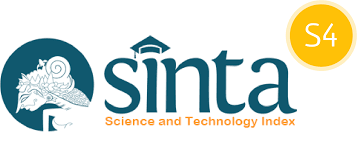Genera Jamur Patogen dan Persentase Penyakit Bercak Daun yang ditemukan pada Pertanaman Sawi Hijau (Brassica juncea) di Desa Serang, Kecamatan Karangreja, Purbalingga
Abstract
Green mustard (Brassica juncea) is an annual or horticultural plant of the Brassica genus. The purpose of this research is to knowledge the type of fungi that cause leaf spot disease on green mustard plants and to know the large percentage of leaf spot diseases caused by fungus on mustard greens in Serang Village, Karangreja District, Purbalingga. This research is used survey method by taking purposive random sampling at two different locations. The type of fungus that causes leaf spot disease on (B. juncea) mustard green can be identified by isolating the part of plants are sick then identified. Identification of fungi is doing by two stages of observation, that is observation macromorphological characters and micromorphological characters. Observation of macromorphological characters includes colony color, colony shape, the edge of colony shape and colony reverse color. Observation of the micromorphology character includes the presence of hyphae, hyphae (insulated or non-insulated), conidia shape, conidia color, additional devices and conidiophores. The next stage to find out the type of fungus that causes leaf spot disease is Koch's Postulate.The results obtained there is one type of disease in green mustard plants. Leaf spot is one of the diseases of mustard greens caused by the fungus Alternaria sp, with a frequency of leaf spot disease as many as 196 times, and the percentage of disease of 51,30%.
References
Barnett, H. L. & Hunter, B. B., 1972. Illustrated Genera of Imperfect Fungi. Burgess. USA: Publishing company.
Chadar, L. K., Singh, R. P., Singh, R. K., Yadav, R. R., Mishra, M. K., Pratap, N., & Vishnoi, R. K., 2016. Studies on Alternaria Blight of Rapeseed-Mustard (Brassica juncea L.) Caused by Alternaria brassicae (Berk.) Sacc. and its Integrated Management. Plant Archives, 16(2): 897-901.
Ekman, J, L Tesoriero, and S Grigg., 2014. Pests, Diseases, and Disorders of Brassica Vegetables a Field Identification Guide. Australia: Horticulture Australia.
Eshraghi, L., Barbetti, M. J., Li, H., Danehloueipour, N., & Sivasithamparam, K., 2007. Resistance in Oilseed Rape (Brassica napus) and Indian Mustard (Brassica juncea) to a Mixture of Pseudocercosporella capsellae Isolates from Western Australia. Field Crops Research, 101(1): 37-43.
Motlagh, MRS., 2011. Evaluation of Curvularia lunata as a Biological Control Agent in Major Weeds of Rice Paddies. Life science Journal. 8(2): 81-91.
Mukarlina, N. D, & Khotimah, S., 2014. Penghambatan Pertumbuhan Jamur Fusarium oxysporum Schlecht pada Batang Padi (Oryza sativa L.) Menggunakan Ekstrak Metanol Umbi Bawang Mekah (Eleutherine palmifolia Merr.). Protobiont, 3(2): 225-231.
Nirmayanti. F,. 2014. Pengaruh Beberapa Jenis Tanaman Pendamping Terhadap Hama Phyllotreta Striolata F. (Coleoptera: Chrysomelidae) Pada Budidaya Sawi Hijau Organik. Jurnal HPT, 3 (2): 2338-4336.
Pramila, P. G., Tasleem, M., Taj, G., Mal, R., & Kumar, A., 2014. Morphological, Cultural, Pathogenic and Molecular Variability Amongst Indian Mustard Isolates of Alternaria brassicae in Uttarakhand. African Journal of Biotechnology, 13(3): 442-448.
Pratap, P., Meena, P. D., Singh, B. K., Meena, S. S., Sharma, P., Majumdar, R., & Singh, D., 2016. Development and Evaluation of Alternaria Blight Tolerant Lines in Indian Mustard (Brassica juncea). Journal of Oilseed Brassica, 1(2):141-148.
Purnomo, D., Sakya, A. T., & Fahrudin, F., 2012. Penggunaan Ekstrak Teh dan Pupuk Kacing pada Budidaya Caisim (Brassica juncea L.). Sains Tanah-Journal of Soil Science and Agroclimatology, 6(2): 61-68.
Rahardjo, I. B & Suhardi., 2008. Insiden dan Serangan Penyakit Karat Putih Pada Beberapa Klon Krisan. J. Hort, 18(3): 312-318.
Ridwan, M., 2019. Produktivitas Tumpangsari Beberapa Varietas Caisim dan Takaran Pupuk Kandang Ayam Dalam Pola Tumpangsari Tanaman Caisim dan Bawang Daun. Jurnal Sains Agro, 4(1): 258-074.
Rotem J,. 1994. The genus Alternaria: Biology, epidemiology, and pathogenicity. St. Paul, MN, USA: American Phytopathological Society Press
Rukmana, R., 1994. Bertanam Petsai dan Sawi. Kanisius: Yogyakarta.
Safitri, I, 2016. Studi Komparasi Usahatani Sayuran di Desa Kutabawa dan Desa Siwarak Kecamatan Karangreja Kabupaten Purbalingga. Geo Educasia-S1, 1(2): 4-15.
Sakurai H, & Fujita S,. 1978. Antifungal Activity of Polyoxin B and Iprodione Against Phytopathogenic Fungi Recently Isolated from Diseased Plants in Japan. Pesticide Science 9: 207-12.
Sangadji, Z., 2018. Kajian Sistem Budidaya Tanaman Sawi (Brassica juncea L) di Petani Kelurahan Malawele Distrik Aimas Kabupaten Sorong. Median: Jurnal Ilmu Ilmu Eksakta, 9(1): 16-24
Semangun, H., 1989. Penyakit-Penyakit Tanaman Hortikultura di Indonesia. Yogjakarta: Gajah Mada University press.
Simmons EG., 2007. Alternaria: An Identification Manual. CBS Biodiversity Series No. 6, Utrecht, The Netherlands: 775.
Singh, D., Prasa, R., Yadav, S. P., & Kumar, S., 2014. Characterization of Alternaria brassicae Causing Alternaria Blight of Rapeseed Mustard (Brassicae juncea L.) and it’s Management. The Bioscan, 9(3): 1207-1212.
Suganda, T., & Wulandari, D. Y., 2018. Curvularia sp. Jamur Patogen Baru Penyebab Penyakit Bercak Daun pada Tanaman Sawi. Agrikultura, 29(3): 119-123.
Supranto, J., 2000. Statistik Teori dan Aplikasi Jilid 1 ED 6, Jakarta: Erlangga.
Suryanti, U. Bintoro, V. P. Atmomarsono, U., Pramono, Y. B. & Legowo, A. M., 2014. Antioxidant Activity of Indonesian Endogenous Duck Meat Marinated in Ginger (Zingiber officinale Roscoe) Extract. Int. J. Poult Sci. 13(2): 102-107.
Sutarman, S., 2017. Dasar Dasar Ilmu Penyakit. Sidoarjo: UMSIDA press.
Thayer CL., 2005. Plant disease forecasting and model validation: Classic and modern approaches. Raleigh, NC, USA: North Carolina State University, Master of Plant Pathology Thesis.
Wakeham, A. J., & Kennedy, R., 2010. Risk Assessment Methods for the Ringspot Pathogen Mycosphaerella brassicicola in Vegetable Brassica crops. Plant disease, 94(7): 851-859.
Wangge, E. S., & Fowo, M. F., 2012. Pengaruh Jarak Tanam Terhadap Pertumbuhan dan Hasil Tanaman Sawi Hijau (Brassica Juncea L). AGRICA, 5(1): 57-66.
Watanabe, Tsuneo., 2002. Pictorial Atlas of Soil and Seed Fungi. America: CRC press.
Winarsih, D., Prihastanti, E., & Saptiningsih, E., 2012. Kadar Serat dan Kadar Air serta Penampakan Fisik Produk Pascapanen Daun Caisim (Brassica juncea L.) yang Ditanam pada Media dengan Penambahan Pupuk Organik Hayati Cair dan Pupuk Anorganik. Bioma: Berkala Ilmiah Biologi, 14(1): 25-32.
Yu, Y., Zeng, L., Huang, L., Yan, Z., Sun, K., Zhu, T., & Zhu, A., 2016. First Report of Black Leaf Spot Caused by Alternaria alternata on ramie in China. Journal of Phytopathology, 164(5): 358-361.
Yudha, M., Soesanto, L., & Mugiastuti, E., 2016 . Pemanfaatan empat isolat Trichoderma sp. untuk mengendalikan penyakit akar gada pada tanaman caisin. Kultivasi, 15(3): 144-149














_copy.png)



